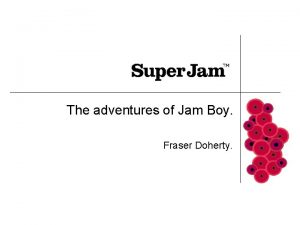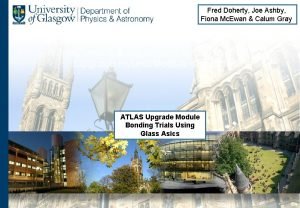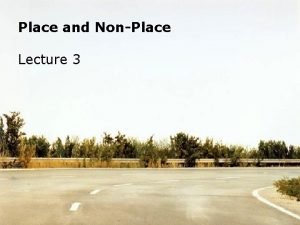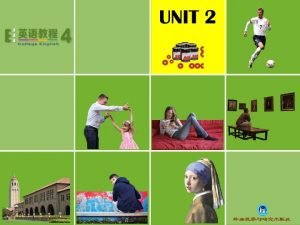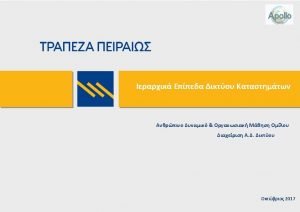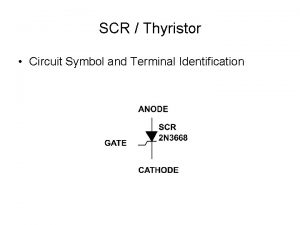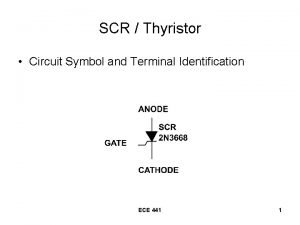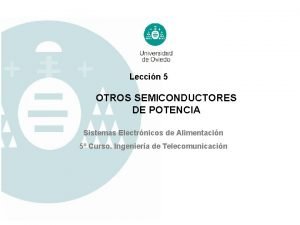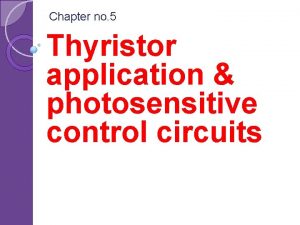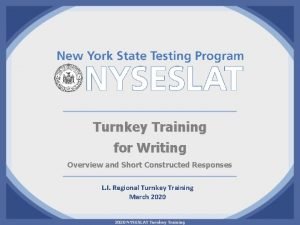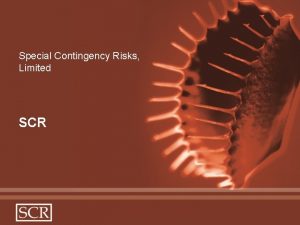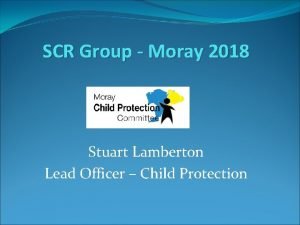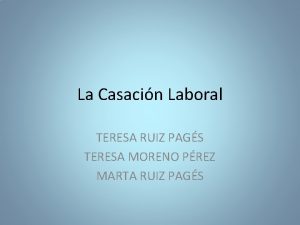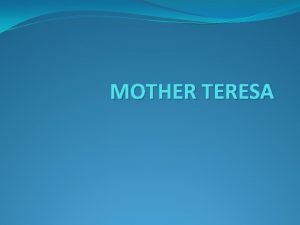Neglectlearning from SCR Teresa Doherty Group Manager QA





















- Slides: 21

Neglect-learning from SCR Teresa Doherty Group Manager, QA & Child Protection Bernadette Roche Group Manager, Care Proceedings

SCRs with Neglect a key issue • • Khyra Ishaq-Birmingham 2008 • Known to Children’s centre, CAF completed, young parents, known to Housing, Children’s centre due to visit mother in new tenancy but could not contact her so no visit took place • GP asked HV to visit as some concerns about parenting but visit took place at MGMs • Children’s centre worker & HV were persistent in trying to make contact • Home conditions deteriorated rapidly in 10 days before T’s death Coventry 2015 Child T-not known to CSC, 3 week old baby. Concerns re squalid conditions only came to light during home visit following the death of T

Essex SCR Child G 2015 • • 3 month old baby with serious injuries • • Mother & her partner-custodial sentence • MGM referred to CSC in first pregnancy as worried about DV, her daughter's mental health and difficult family relationships. Mother also had learning difficulties. • CIN plan not robust enough, not good multiagency work, closed after 2. 5 months Older sibling, 3, had been subject to CP plan, stepped down at 2 nd review Mother had been vulnerable teenager-missing, allegations of sexual abuse

Essex SCR • • Partner violent-known to MAPPA • Nothing on GP records re vulnerability, health visitor did not access half siblings records so concerns not flagged up • Flagged up to offender manager that Mr A had a partner with children-no urgent referral made • Baby taken to minor injuries unit-mother says sibling dropped her on her head. Not fully examined, mother told to go to A&E, no ambulance transfer. • Fractured skull-partner convicted of GBH Midwifery-focused on mother/pregnancy— challenge re “whole family approach”-incidents during pregnancy should have led to CSC referral

• Lambeth-Child I 3 rd child in sibling group of 4 (Children aged 6, 3, 20 months and 9 months). White British family • Aged 1 year, 8 months when he died • Parents in their mid-twenties, level of learning difficulty • First referred in 2010 before birth of second child-concerns re vulnerable, isolated family, poor parenting capacity and domestic violence

• August 2011 CP investigation following injury to oldest child’s eye • Children subject to CP plans for Neglect from November 2011 • July 2013 Child I found drowned in the bath • Mother said she had put child in the bath, telling the father, before taking eldest child to school • 3 siblings removed and placed in foster care

• Local Context in Lambeth • CP plans increased from 210 to 320 in the preceding 3 years • Impressive range of services available and a number were of good quality • Practitioners demonstrated a heartfelt desire to improve outcomes for the children • • There were tangible improvements • At times working in isolation trying to improve outcomes for separate parts of the family system • Struggle to balance support for parents with focus on needs of children Practitioners wanted to support two vulnerable young parents

Your experience of Neglect • Discuss with your immediate neighbours your experience of neglect in your work • What did you use to assess the level of risk? • What services were put in place?

Early Intervention • • May 2010 -November 2011 • Early signs of cooperation from mother, father hostile • • EI SW allocated and meetings held • Parent’s history, their unmet emotional needs, lack of any change in parenting not recognised as indicators of harm Support from Leaving Care team, Youth support services and MAT (Multi Agency team) They were inconsistently attended and emphasis on unmet need rather than risk

Response to child injury & services • Good investigation, CP medical • Delayed ICPC • Information shared at ICPC about risks to children were sufficient to progress to more robust intervention-should have been LPM • CP conferences and Core Groups held on time but no pre-birth assessments for new children, specific needs of new infants not considered • Risk due to increasing size of family not considered • Plans from CPCs and Core Groups remained the same • All key professionals did not attend CPC/Core Groups

Drift • Mother was doing her best, house reasonable, food in the house, appointments attended • Onus of intervention was “disproportionately slanted” towards providing more and more services • Critical aspects of CP plan not implementede. g. repeated plan re Parenting assessmentrequests to fund declined, this then became “stuck”-not enough challenge from anyone about this • 6 CPCs & 13 Core groups, no effective challenge, stalemate re assessment funding • Lack of ownership-assumption that CSC were fully responsible

Your role • What could/should/would you do if you were part of this scenario? • What might the barriers be?

Assessment and response to Neglect • Multi-agency network struggled to understand concept of neglect-little consideration of cumulative impact • • • Lack of decisive action • Judgement based on “here and now” Drift tolerated Superficial response to presenting need Whole picture not brought together No service dealt with causes of neglect Progress seen in terms of mother’s ability to access services

Evidence • What evidence of Neglect might you expect to see in the children in this family? • How do you distinguish between “low -level” neglect and neglect where the impact is very harmful? • What helps you to do this well?

Evidence of Neglect • Unmet emotional needs in eldest children • • • Lack of supervision leading to injuries Lack of proper care re medical needs Developmental delay Conflict/anger in home environment Not assessed properly partly due to absence of good assessment frameworks/tools/guidance

What could have been improved? • Ownership-reluctance to make decisions about risk-incident driven • • Supervision/Challenge • Good examples of children being observed at home “in their own bubble” but no insight into what this meant • Emphasise on investigating/proving re physical injuries rather than wider neglect indicators but some injuries not investigated • Strengths-family support-too much weight Parental behaviour was observed but not analysed-emotional needs of parents eclipsed those of

What could have been improved? • Father, known to function at half his chronological age as a teenager did not feature strongly in assessments • Assumed learning difficulties elicited sympathy but insufficient attention to impact on parenting • Written agreements-continually breached with no action, not really understood, false sense of security • Assumption basic care needs met (Sibling 3 lost weight-not monitored) • Parents “I just did not know what I was meant to be doing” • Felt “ambushed” at meetings like CPCs-had not seen reports in advance

• SCR reviewers noted Mother had hearing impairment-not flagged up-had she heard discussions? • Clear guidance re working with hostile families but this behaviour still disrupts effective functioning of CP process • Rough handling, inconsistent administration of medical treatment, poor hygiene-dealt with incident by incident-not used to form the bigger picture • Lack of clarity re neglect thresholds-legal threshold felt too high • • Confusion and despondency in professionals Parents aggressive even when children present -this inhibited discussion re plans/challenge

Research “While there is no association between learning difficulties and wilful neglect there is considerable evidence to suggest children suffer neglect by omission as a result of a lack of parental education combined with the unavailability of supportive services” Children’s needs: Parenting capacity: Cleaver & Nicholson et al 2011 • SCRs-For 59 children, a CP neglect plan was in place at the time of their death or serious harm, for the other 42 children the plan had been discontinued. This shows that some children living with substantiated neglect may be at risk of death, not just long term developmental damage…Neglect was therefore by far the most frequent category of CP plan in SCR sample

Research • Thriving Communities: a framework for preventing and intervening early in child neglect. NSPCC 2015 • 3 key building blocks underpin actions to prevent neglect • Relationships: child/parent, practitioners, communities and support networks are key • Knowledge and awareness-what is it? Why does it happen? What do we do about it? • Evidence-based responses-what do we know works, tools and services • https: //www. nspcc. org. uk/globalassets/docu ments/research-reports/thrivingcommunities-framework-neglect-report. pdf

• Research Neglect Matters (University of York, NSPCC 2010) • “It takes a lot to build trust”: Recognition and telling: Developing earlier routes to help for children and young people. • J. Cossar, M. Brandon, S. Bailey, P. Belderson, L. Biggart & D. Sharpe (University of East Anglia) • www. signsofsafety. net
 Teresa doherty darts
Teresa doherty darts Conor doherty model
Conor doherty model Aisling doherty
Aisling doherty Fraser doherty jam
Fraser doherty jam Fred doherty
Fred doherty Michael doherty maynooth
Michael doherty maynooth Willie doherty photographer
Willie doherty photographer Fraser doherty superjam
Fraser doherty superjam Senior manager vs general manager
Senior manager vs general manager Portfolio manager synergy manager parental developer
Portfolio manager synergy manager parental developer Scr symbol
Scr symbol How to identify the terminals of scr
How to identify the terminals of scr Scr protection
Scr protection Interceptor nomaki
Interceptor nomaki Scr como funciona
Scr como funciona Formula scr
Formula scr Scr forced commutation
Scr forced commutation Emergency light system control using scr
Emergency light system control using scr Char *scr
Char *scr Nyseslat writing rubric 5-6
Nyseslat writing rubric 5-6 Cara menentukan kaki scr
Cara menentukan kaki scr Special contingency risks
Special contingency risks



